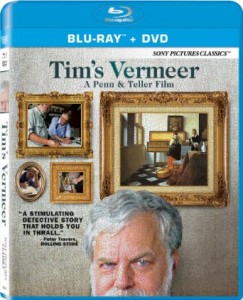When I walked into the library, our usually calm librarian started to bubble. “Remember that DVD you recommended, Tim’s Vermeer? I just watched it!” And then, for the next five minutes she flitted from one scene or concept to the next, exclaiming, explaining, commenting, and enjoying the memories.
My teen daughters were not quite that enthusiastic, but they, too, were fascinated and learned a lot about art history, about optics in the 17th century, and about determination.
So, what is Tim’s Vermeer all about?
It addresses the enigma of the 17th century Dutch painter, Vermeer, from the viewpoint of a geek in the 21st century, suggesting that Vermeer used various arrangements of lenses and mirrors to paint his luminous scenes. Historically, this approach is possible; in the days of Vermeer there was no artificial division between art and science. Life and society were more unified in these respects and artists, who classed themselves among craftsmen, had not yet acquired the bohemian, angst-filled, anti-technology identity that is common (and probably inevitable) in our post-Christian era.
So Tim Jenison developed a hypothesis about how Vermeer, using the optical possibilities of his day, may have painted his incredible paintings. And then, because he is wealthy, Tim was able to follow up on his ideas, research them, and actually paint the picture as Vermeer may have done. What results is a fascinating and occasionally humorous experiment on a vast scale that taxes Tim to the limit but seems to validate his idea.
Not everyone agrees with Tim’s ideas, though similar ones have been discussed extensively among art historians. However, as a physicist, an art enthusiast, someone who loves to think about light, and a person who has lived in the Netherlands, I find it interesting to ponder the following points:
–There is no provision in Tim’s method to deal with the subtle but significant changes in light from hour to hour as well as from day to day and season to season in the Netherlands. Texas weather is, from what I understand, stable enough for light to be similar at many times, and that is where Tim worked. My experience of Dutch weather is entirely different, and Tim does not deal with that question.
–Tim’s method requires a lot of time. How is it possible paint something as moveable as the pouring milk in The Milk Maid, for example? This is related to Nelleke’s questions about Vermeer’s subject’s fleeting facial expressions, which is an issue no matter how the painting was done.
–Since Vermeer was at least somewhat associated with Van Leeuwenhoek, the lens maker who worked on the microscope, he would have had access to the lenses required for Tim’s theory.
–However, it is possible that he used optical effects, which he obviously did, without doing the entire paintings using lenses and mirrors.
–In The Art of Painting, Vermeer did not show the artist using any sort of optics. This raises many interesting questions, some of which are discussed under ‘special topics’ at the given link.
Although Tim based his ideas on those of respected art historians, not all of them agree with him or each other. I hope to read Eye of the Beholder: Johannes Vermeer, Antoni van Leeuwenhoek, and the Reinvention of Seeing to learn more about Dutch art and optics in the 17th century.
How did Tim’s Vermeer fit into our homeschool learning? My teens learned about Vermeer, light, art historians, painting, optics, and thinking outside the box. The movie’s story line captivated them despite their initial resistance, making Tim’s Vermeer a dramatic introduction to our video-based art history studies.
To find out more about this movie, see the trailer. Note that there are a few language issues and also that the director and producer are not generally recommended. Even so, we recommend Tim’s Vermeer for teens and adults, especially homeschoolers studying art history, the physics of optics, Dutch history, or creativity–both in Vermeer and in Tim.
You can see Vermeer’s works here. I have had the opportunity to see a few of them in real life; because I was accompanied by children, I could never look at them long enough, but even so it was a remarkable experience.
I find that Helmantel sometimes does similar things with light, although his subject matter is not at all like Vermeer’s.
Disclosure: I borrowed this DVD from the library and am not compensated for this review. I would like to thank Nelleke of Education is a Life for introducing me to this remarkable movie.


It is in transit to my local OPL as I type… I am never disappointed it your recommendations.
Blessings – Kathleen
Thank you for your encouragement. I’m sure you will enjoy it.